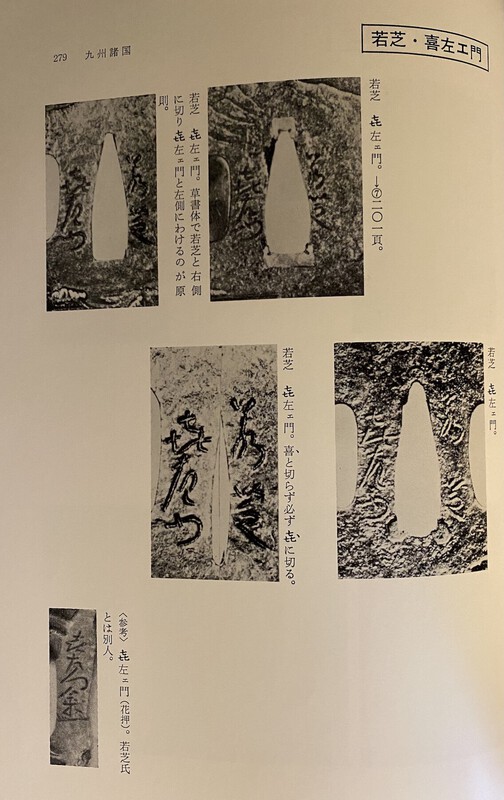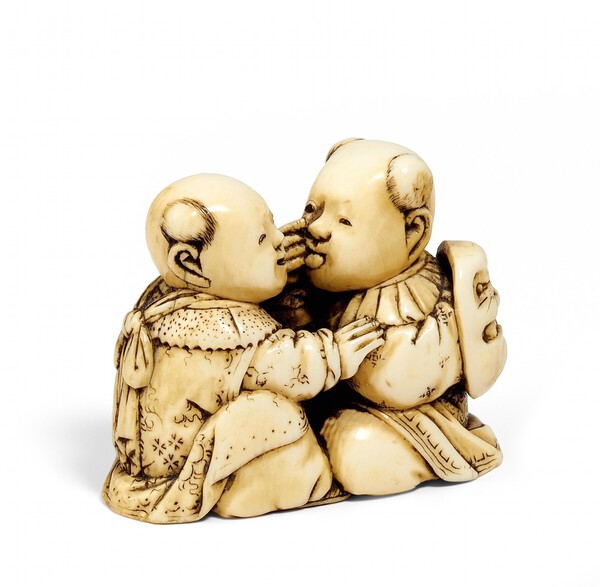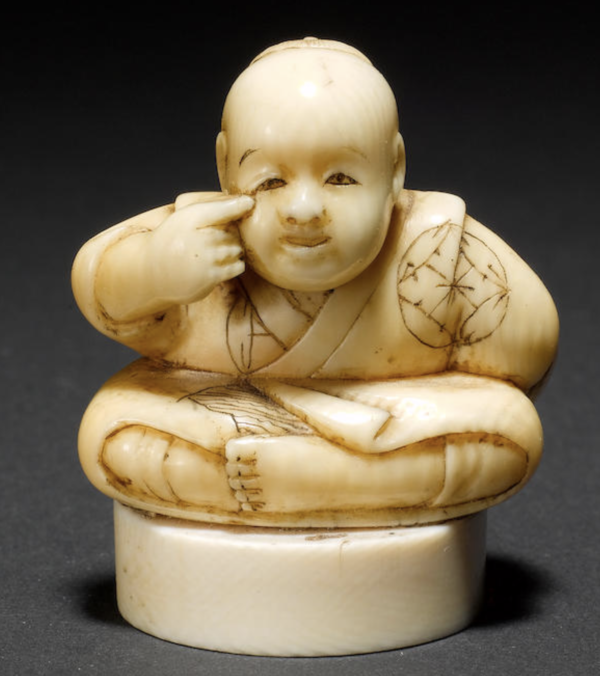-
Posts
858 -
Joined
-
Last visited
-
Days Won
7
Content Type
Profiles
Forums
Events
Store
Downloads
Gallery
Everything posted by Tanto54
-
Dear Bob, sorry I'm a little behind. On your item 39, I think that it is Third Generation Jakushi (Shiroki) (Haynes 02014). Although Haynes says that his work had lost the Chinese Landscape Style of the first two generations, this is probably one of his earlier works. I come to this conclusion because Haynes has 5 Jakushi using these kanji. The first two generations' mei don't match and it looks like they almost always used more than a two character mei. The Third Gen's mei matches exactly, and he signed with two characters. The two remaining Jakushi used more than two characters in their mei too. Therefore, despite Haynes comment about the Third Generation moving away from the traditional Chinese Landscape Style, his mei is an exact match and the others are not. Here are the mei from Wakayama. Third and subsequent generations of Jakushi (I think yours matches some in this grouping): Here are the first two Generations:
-
Dear Bob, On No. 38, it looks like an early mei of Haynes 06403 Myochin Kingyokudo (it could also be an early mei of Hirosada). This Myochin is, of course, not related to the famous armorers but may be related to the Umetada family. The work looks like something that he could have done early in his career to me.
-
Scratching my head on this one... A couple of thoughts and questions: Is that a bird chirping on the Ura at the end of the "pole"? (can't see clearly) If so, could this be related to the Tongue Cut Sparrow Story (Shita-Kiri Suzume)? The "pole" might be a wooden pestle (Nyūbō or Surikogi), and therefore, alluding to the rice starch from the Sparrow Story. Alternatively Nyūbō could be some kind of wordplay with the word for priest (but I doubt it...).
-
Dear Bob, I think Number 35 is Umetada.
-
Curran - that's a beauty!!!
-
Thank Guys -I appreciate the kind words - it really is my pleasure!
-
Dear @Barrie B, The masks on your sword are Okame (also called Otafuku/Ofuku/Uzume) and Hyottoko (“fire man”). They are usually considered a pair (and have been for hundreds of years). Some traditions call them husband and wife. Together they symbolize good luck and jolliness. Okame is also known as the Moon Goddess who played a very important role in getting the Sun Goddess (Amaterasu) to come out of her cave and give light to the World (part of the legends of the founding of Japan). She did a bawdy dance dropping her clothes and making all the other gods laugh, so Amaterasu (the Sun Goddess) came out of her cave to see what was happening. Believe it or not, Okame was originally considered the epitome of Japanese beauty (evidentially Dale @Spartancrest doesn’t care for the ancient beauty standards in Japan… personally I'm with Dale...) Today they are very common masks that are used in lots of festivals in Japan. As I’ve said before, while this is a wakazashi, it is not necessarily a “merchant sword” (working hard to get rid of that old and misinformed stereotype…) Okame derived from Noh plays which were written by and performed for the aristocracy (Samurai, NOT merchants). While she has evolved into a more common figure, Okame’s origins were in the Bushi class. Grev @kissakai, yours is fascinating because it shows a man stuck between the two, diametrically opposed versions of a woman. Your menuki are Okame and Hannya. Okame is considered the perfect Wife (ever cheerful and supportive) whereas Hannya (on the opposite side) is considered the ultimate jealous woman. In one of the Okame legends, she was supposedly based on a real Wife who gave her own life in support of her husband. Hannya on the other hand became so jealous that she was transformed into a horned devil with a serpent’s body that became so hot that she burned her lover to death in jealousy. Your sword must have been designed by Freud, because your kashira is Hyottoko (the Husband) caught between these two extremes!
-
Thank you Paul! These exercises are great - still learning by watching...
-
Dear Bob, On Item 33, instead of Haynes 04585, I believe it is a different artist (Haynes 04584) for several reasons. First, the style of the work does not seem to match Haynes 04585, and second, on Haynes' own website he indicates that a tsuba with a very similar style and the same mei as your tsuba is Haynes 04584 (instead of 04585). In your writeup, you provided some background information about the artist that might lead someone to think it was Haynes 04585 (e.g., a pupil of Masatsune), but I'm not sure where that information came from or if it is correct. Here are signatures of Haynes 04585 from Wakayama and Sesko (which are fairly similar, but not exact (and use a different location) and the edges of the mei photos show a consistent artistic style for his tsuba that is very different from your tsuba). I have also attached a page from the Haynes' website with an exact signature. location (and artistic style) match from Haynes 05584 (where Haynes points out that "this is not the Kitani man of a generation before" meaning NOT Haynes 04585). http://www.shibuiswords.com/haynesTsu52.html
-
Sorry, modern Chinese fake - (whoever is telling the 80 years old story is fibbing...)
- 5 replies
-
- 7
-

-
- translation
- tachi
-
(and 1 more)
Tagged with:
-
Dear Bob, Most adults in Japan would know this gesture as "Akanbe" (or Akambe or Akkanbee). I do not think that many modern Japanese would know about the Akanbe Game or know the word "Bekkako" (which I believe is the original name for the gesture). Even though the Japanese are very polite, most current adults would have used this gesture when they were kids (although not in this game) and many "playful" adults might still use the gesture from time to time.
-
Dear Craig, Instead of mon, I think that the dots (one central dot surrounded by multiple smaller dots) are lichen. That is how they are generally depicted in Japanese art. So if they are lichen, then these would be rocks instead of mountains. The "S" shaped "path" is also a stylistic way of depicting water in a stream in Japanese art, so I think your idea of mossy rocks in a stream is probably correct. Here are lichen on a tree:
-
Dear Bob, Number 29 is a very rare subject on tosogu. It is the Akambe Game being play by two boys, and the boy on the kashira is doing the Bekkako gesture (pointing to his eye or pulling down his lower eyelid meaning "do you see any green in my eye" while slightly sticking out his tongue). When playing this game, a mask (Okame or other Noh character mask) is often hidden, so there may be a mask on the other side of the fuchi or perhaps on the menuki or tsuba. While they are very nice and expressive, I think that your instincts are correct about them not being Joi level... Here's the subject on netsuke:
-
Dear Bob, I'm with Geraint - that's an excellent face! Very expressive. Bob, I know that you know the subject is Moso, but for some of our colleagues who don't know Moso's story, here's a summary that I recently wrote for someone else: We sometimes see a man with a straw hat and mino (rain coat) or hoe digging up a bamboo shoot in the snow on tosogu. If we see this in a museum or book, usually the caption is nothing more than "Moso and bamboo shoot" leaving the viewer rather flat and uninspired. Many of the collectors that I know would shun this type of tosogu thinking that must have been for tourists or merchants because no “self respecting Samurai" would want a farmer on his tosogu. However, when you know that Moso is one of the classical paragons of filial virtue who was held in very high regard by Samurai as a reminder to be faithful to their parents and family, it changes your appreciation of the piece. As you may know, Moso’s mother was on her deathbed and she expressed a desire to eat stewed bamboo shoots (usually a Spring delicacy). It was snowing and the middle of Winter, so Moso knew that there wouldn’t be any bamboo shoots. Nevertheless, he hiked many miles into the mountains where the bamboo grew and started digging in the snow while weeping about his mother’s impending death (makes the expression on his face on your kozuka more meaningful). The gods rewarded his devotion by causing bamboo shoots to spring up under the snow, so Moso was able to grant his mother’s last request. A sword with this motif would have been an excellent gift from Samurai parents to their son, or for a Samurai who wanted a daily reminder to serve his family well. This knowledge would not only prevent some collectors from passing up such a sword/tosogu, but should also significantly add to the enjoyment of the owner/viewer who now has some insight into the life and character of the Samurai who carried the sword/tosogu.
-
Dear Bob, let me second Barry... I'm sure that everyone is enjoying the eye candy - please keep it up!
-
Hi Bob, checking in late today. Geraint beat me to it - this is a common motif but few Westerners know the meaning - great job Geraint!
-
Dear James, First of all, congratulations! Many new collectors bought fake swords or total "dogs" for their first sword. Based on what I can see in the photos (it would be better for someone to see it in person...), the blade is legitimate but not very old and is probably not very valuable. In order to properly fix the blade, you'd need to get it polished and that would most probably cost more than the sword is worth (it costs several thousand dollars for a polish). However, if the sword has special meaning to you, then you might want to do that anyway. As Grey said, don't let an amateur do anything to the blade or fittings - it will definitely ruin any of the current value. Only a properly trained polisher (who has trained for many years in the Japanese polishing tradition) could polish this without reducing its value. The fittings tell us that this was cobbled together by someone who did not know what they were doing (outside Japan - probably in an effort to get a higher price). The fuchigashira (the pommel and collar on the handle) look like they were pretty good at one time; however, someone has painted them black in places to coverup worn patina. Similarly, the habaki has been painted black (and may not be from this sword), and one of the menuki (the decorations under the handle wrap) is missing (and the remaining one may be a modern copy). Correcting all these problems would cost several thousand dollars and in the end, you probably wouldn't be able to recover that cost if you sold it. Having said that, it would be a good idea to take a look at the nakago (the tang under the handle) to see if the sword is potentially more valuable than it appears. Someone like Brian (who Grey mentioned) or Ted Tenold could probably help you get the handle off without causing damage and give you an honest idea of the value of the sword (I do not have any commercial connection to either of these gentlemen - I just know that they have very good reputations for work and honesty). Finally, like I said before, you've done better than many of us on your first sword, and you can keep it like it is and enjoy it for a long time (please do look at the care instructions and keep it properly oiled).
-
Hi James, Just checking to make sure you took the mekugi (small bamboo peg that holds the sword in the handle) out before trying to remove the sword (sorry if you already know that, but it's a mistake that many newcomers make). I notice that it is still in place in all the photos. It's the small peg in the handle about an inch below the blade guard (it only comes out in one direction). If you have already tried that, how do you know it's been glued? The habaki and some of the tosogu look like they've been spray painted black (a definite sign of a Western "fix it upper"...). The hada (surface "skin" of the blade) looks like it's been "polished" (improperly too...) I also notice a few fingerprints on the blade which can cause problems. Look at the info linked at the top for how to care for a sword if you don't already know. To answer your question, yes, there are several people who could help with these problems, but in general, it is expensive to get it done right and from what I can see of your tanto, it might not be economically worth it to fix everything... Let me know about the mekugi and I can offer further info.
-
Hi Bob, On Number 24, instead of First Master of the Yagami School (Haynes Index no. H05200), your tsuba is by the Third and final Master of the Yagami School (Haynes Index no. H05202) who was a descendant of the First Master (see Haynes entry below). The tsuba reads: Nagasaki kuni ju nin ("living in Nagasaki"); Kounshi kore [wo] horu ("Kounshi this carved"); Yagami Mitsuhiro. He was the son, nephew or grandson (it is unclear) of the First Master.
-
lotus blossoms (leaves unfurling...)
-
Hey Bob, for Number 18, there are 5 kanji - three on the right and two on the left. If it were a mei, then the two on the left would be the name. Those two characters do not match any recorded artist (including Sueshiro Magoyuki - which would be a very nonstandard name anyway). I checked Haynes and other sources. On the other hand, if it is a poetic saying (as I am suggesting), it would be read from right to left. In that case the three characters on the right are (from top to bottom) "Matsu dai ni" and the two on the left are (from top to bottom) "nokosu kore". In traditional Japanese poetic reading (taken from Chinese grammar), that would be read: "Matsudai ni kore nokosu" and mean "leaving this for future generations/eternity." Therefore, you can't have both the poetic saying and a mei - you don't have enough characters. The poetic saying above uses all five kanji, and none of the kanji in any combination make up a name that I can find in Haynes. Nevertheless, I recommend that you post this one in the translation section and see what the experts there think. P.S. the Naunton Collection Book has many errors....
-
Dear Bob, For Number 19, I guess a beautiful woman...
-
Dear Robert, Based on @MauroP's excellent work, your guy is probably Haynes 04846.0, Family Name: Sekihara; Original Name: Koryusai; He worked in Aizu in Iwashiro Province from around 1800 -1850. He worked in the style of Aizu Shoami from the School of Masamitsu (Haynes 04186)
-
Dear Bob, I would read No. 18 as a message instead of a name/mei: "Matsudai ni kore nokosu." (I checked Haynes just in case and cannot find anyone with a name like this). Instead of the "last of a family", the meaning is "leaving this for future generations/eternity." That's the kind of message that a maker might put on the Omote of a tsuba that he was particularly proud of... Love the dragon's scales and feel that the nakago-ana points toward an interesting sword.


















